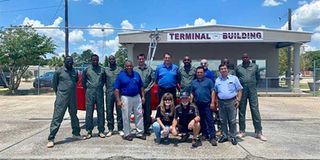KWS pilots get special training at Hammond Airport, USA

The KWS pilots, flanked by their trainers, at the Hammond Northshore Regional Airport in the US where they received a one-month specialised training on how to handle gyrocopters. The training aims to help KWS in wildlife management. PHOTO | COURTESY | KWS
What you need to know:
- A gyrocopter is a rotary-wing aircraft that uses a propeller and a freely rotating rotor for lift.
- Besides the pilots’ training, KWS will also receive five gyrocopters under the project.
- KWS only manages to cover eight percent of the whole landmass in fight against poachers.
Seven Kenya Wildlife Service (KWS) pilots have received specialised training in the US which aims to help support wildlife management.
The pilots received the training on how to handle gyrocopters at the Hammond Northshore Regional Airport for one month.
Also receiving a separate training on maintenance of gyrocopters are two engineers, one from the Kenya Civil Aviation.
The training, according to a statement sent to newsrooms by KWS, took pilots from Kenya to Hammond and Elizabeth City State for specialised training.
The seven are Michael Nicholson, John Munyori, Kennedy Shamala, Chris Cheruiyot, Isaac Oyile, Moses Mwiti and Saidi Bashane.
AVIATION SOLUTIONS
A gyrocopter is a rotary-wing aircraft that uses a propeller and a freely rotating rotor for lift.
The project was initiated when the North Carolina University received a grant of more than USD900,000 (Sh90million) in 2015 from the Office of Justice Programmes’ National Institute of Justice to introduce affordable aviation solutions to support KWS in its conservation agenda.
“Pilots track poaching, illegal logging, fires and other threats to wildlife, provide intelligence to rangers on the ground, act as deterrent and help mitigate any undue occurrences before they happen,” KWS Airwing Chief Pilot John Munyori said.
POACHERS
Currently, KWS only manages to cover eight percent of the whole landmass covering 30,000 nautical miles per month across all conservation areas in the country in their fight against poachers who mostly target rhinos and elephants due to their prized horns.
Besides the pilots’ training, KWS will also receive five gyrocopters under the project.
“The aircraft are convenient for surveillance, since they have open cockpits, providing wide visibility. The planes can be stopped mid-air and can be landed in about 15 feet. This makes the aircraft perfect for law enforcement as it has worked in many countries across the world,” chief trainer Stephen Rastanis said.



